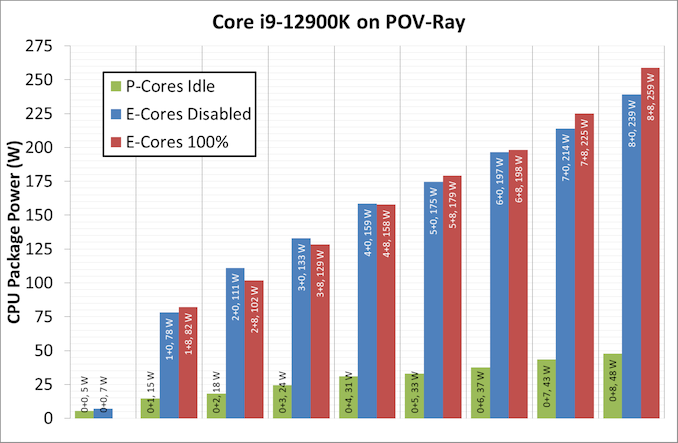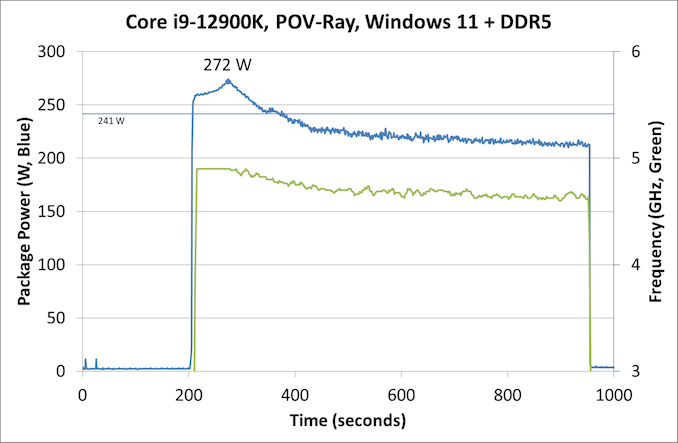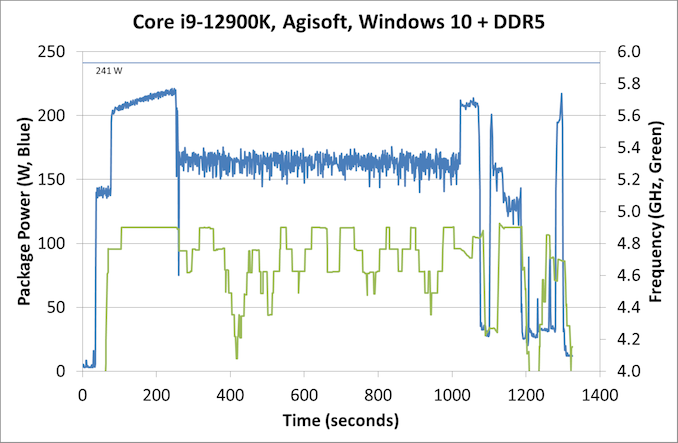The Intel 12th Gen Core i9-12900K Review: Hybrid Performance Brings Hybrid Complexity
by Dr. Ian Cutress & Andrei Frumusanu on November 4, 2021 9:00 AM ESTPower: P-Core vs E-Core, Win10 vs Win11
For Alder Lake, Intel brings two new things into the mix when we start talking about power.
First is what we’ve already talked about, the new P-core and E-core, each with different levels of performance per watt and targeted at different sorts of workloads. While the P-cores are expected to mimic previous generations of Intel processors, the E-cores should offer an interesting look into how low power operation might work on these systems and in future mobile systems.
The second element is how Intel is describing power. Rather than simply quote a ‘TDP’, or Thermal Design Power, Intel has decided (with much rejoicing) to start putting two numbers next to each processor, one for the base processor power and one for maximum turbo processor power, which we’ll call Base and Turbo. The idea is that the Base power mimics the TDP value we had before – it’s the power at which the all-core base frequency is guaranteed to. The Turbo power indicates the highest power level that should be observed in normal power virus (usually defined as something causing 90-95% of the CPU to continually switch) situation. There is usually a weighted time factor that limits how long a processor can remain in its Turbo state for slowly reeling back, but for the K processors Intel has made that time factor effectively infinite – with the right cooling, these processors should be able to use their Turbo power all day, all week, and all year.
So with that in mind, let’s start simply looking at the individual P-cores and E-cores.
Listed in red, in this test, all 8P+8E cores fully loaded (on DDR5), we get a CPU package power of 259 W. The progression from idle to load is steady, although there is a big jump from idle to single core. When one core is loaded, we go from 7 W to 78 W, which is a big 71 W jump. Because this is package power (the output for core power had some issues), this does include firing up the ring, the L3 cache, and the DRAM controller, but even if that makes 20% of the difference, we’re still looking at ~55-60 W enabled for a single core. By comparison, for our single thread SPEC power testing on Linux, we see a more modest 25-30W per core, which we put down to POV-Ray’s instruction density.
By contrast, in green, the E-cores only jump from 5 W to 15 W when a single core is active, and that is the same number as we see on SPEC power testing. Using all the E-cores, at 3.9 GHz, brings the package power up to 48 W total.
It is worth noting that there are differences between the blue bars (P-cores only) and the red bars (all cores, with E-cores loaded all the time), and that sometimes the blue bar consumes more power than the red bar. Our blue bar tests were done with E-cores disabled in the BIOS, which means that there might be more leeway in balancing a workload across a smaller number of cores, allowing for higher power. However as everything ramps up, the advantage swings the other way it seems. It’s a bit odd to see this behavior.
Moving on to individual testing, and here’s a look at a power trace of POV-Ray in Windows 11:
Here we’re seeing a higher spike in power, up to 272 W now, with the system at 4.9 GHz all-core. Interestingly enough, we see a decrease of power through the 241 W Turbo Power limit, and it settles around 225 W, with the reported frequency actually dropping to between 4.7-4.8 GHz instead. Technically this all-core is meant to take into account some of the E-cores, so this might be a case of the workload distributing itself and finding the best performance/power point when it comes to instruction mix, cache mix, and IO requirements. However, it takes a good 3-5 minutes to get there, if that’s the case.
Intrigued by this, I looked at how some of our other tests did between different operating systems. Enter Agisoft:
Between Windows 10 and Windows 11, the traces look near identical. The actual run time was 5 seconds faster on Windows 11 out of 20 minutes, so 0.4% faster, which we would consider run-to-run variation. The peaks and spikes look barely higher in Windows 11, and the frequency trace in Windows 11 looks a little more consistent, but overall they’re practically the same.
For our usual power graphs, we get something like this, and we’ll also add in the AVX-512 numbers from that page:

Compared to Intel’s previous 11th Generation Processor, the Alder Lake Core i9 uses more power during AVX2, but is actually lower in AVX-512. The difficulty of presenting this graph in the future is based on those E-cores; they're more efficient, and as you’ll see in the results later. Even on AVX-512, Alder Lake pulls out a performance lead using 50 W fewer than 11th Gen.
When we compare it to AMD however, with that 142 W PPT limit that AMD has, Intel is often trailing at a 20-70 W deficit when we’re looking at full load efficiency. That being said, Intel is likely going to argue that in mixed workloads, such as two software programs running where something is on the E-cores, it wants to be the more efficient design.














474 Comments
View All Comments
Ppietra - Friday, November 5, 2021 - link
It’s not context switch, Geekbench deliberately pauses between tests to avoid throttling. Read about it.Notebookcheck didn’t make them up either and you can see higher scores inside Geekbench database.
Spunjji - Friday, November 5, 2021 - link
11980HK to 11700K isn't a useful analogue - it's 10SF vs. 14++++ and the caches on TGL-H45 are large than RKL.I'd be comfortable predicting that ADL mobile will be ~15% faster than TGL all-round, with better gains in power-limited multithreading scenarios where the E cores are properly utilised.
geoxile - Friday, November 5, 2021 - link
That's a valid point. But we can still look to the zen 3 APUs vs the desktop 5800X and see similar or better perf/W scaling. Based on what we've seen so far ADL is very comparable to zen 3 in efficiency in heavy synthetic loads when set to optimal PL (e.g 150W) and far, far more efficient in mixed loads like gaming, where a 12900k with PL 241 uses 60-70% the power of a stock 5950X. These are good signs."Apples to Apples", like 8 TGL cores vs 8 mixed ADL cores I'd agree. But the leaked configurations are 8+8 for 45W (up to 55W cTDP), or 6+8 at 35-45W. I think e-cores will make a huge difference.
Wrs - Thursday, November 4, 2021 - link
*raises hand* You can restrict the TDP of any Intel/AMD consumer processor. Or you can raise it, subject to physical/overclocking limits. It's user choice. I never complain when they're giving us choice.Process node advancement is in the right direction. In terms of efficiency, Intel is one full node behind the leading edge, which Apple basically has exclusively. No other high-volume chip is comparable to N5, even the Snapdragon 888 (though Samsung calls it 5nm).
Bobbyjones - Thursday, November 4, 2021 - link
Huge improvements for Intel, beats Zen 3 soundly in performance almost across the board. The 12900k is a beast. However its the 12600k that is the real champ, half the price of a 5800x and it still beats it.No surprise that 12th gen is sold out everywhere online, it seems like the Zen 3/AMD era is dead and Intel is back.
Spunjji - Friday, November 5, 2021 - link
"it seems like the Zen 3/AMD era is dead"No need to overstate the case
mode_13h - Friday, November 5, 2021 - link
> it seems like the Zen 3/AMD era is deadPremature. We don't yet have real world performance data on their V-Cache version.
kobblestown - Thursday, November 4, 2021 - link
I find the argument for disabling AVX512 really not convincing. If a process is running on an E core and reaches nonexisiting instruction it traps into the OS. The OS can determine that it's an instruction that can be executed on a P core and reschedule it there, keeping note to not move that process/thread back to an E core. It shouldn't have been too hard.SarahKerrigan - Thursday, November 4, 2021 - link
AVX512 implies a lot more than ops - it implies a whole set of state as well. Trap-and-move would be very non-trivial.kobblestown - Thursday, November 4, 2021 - link
Citation please.